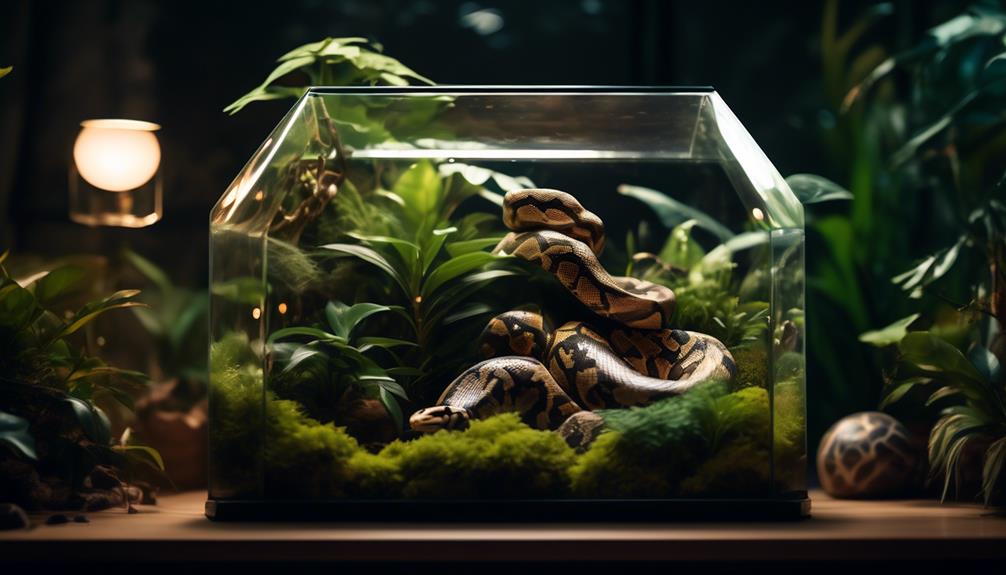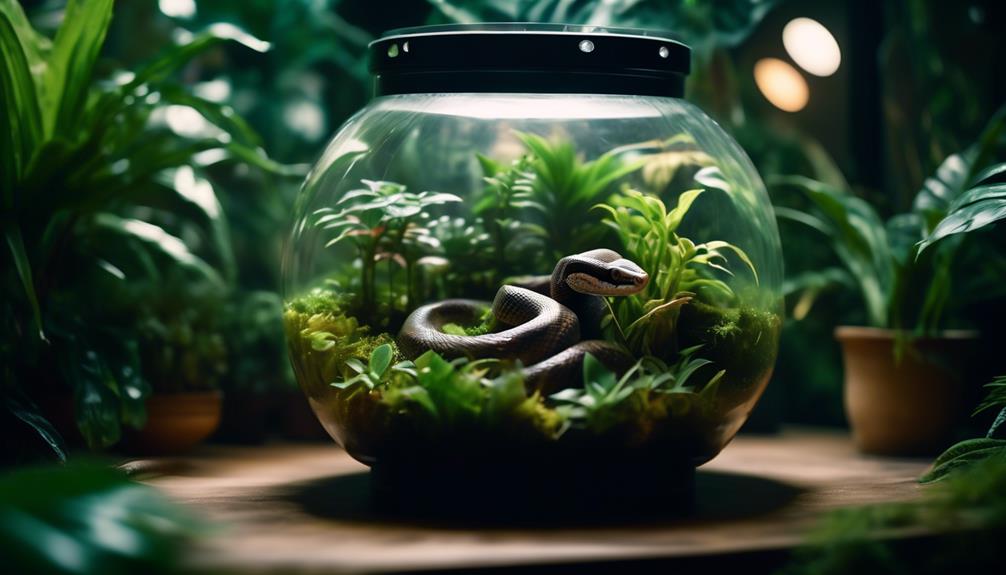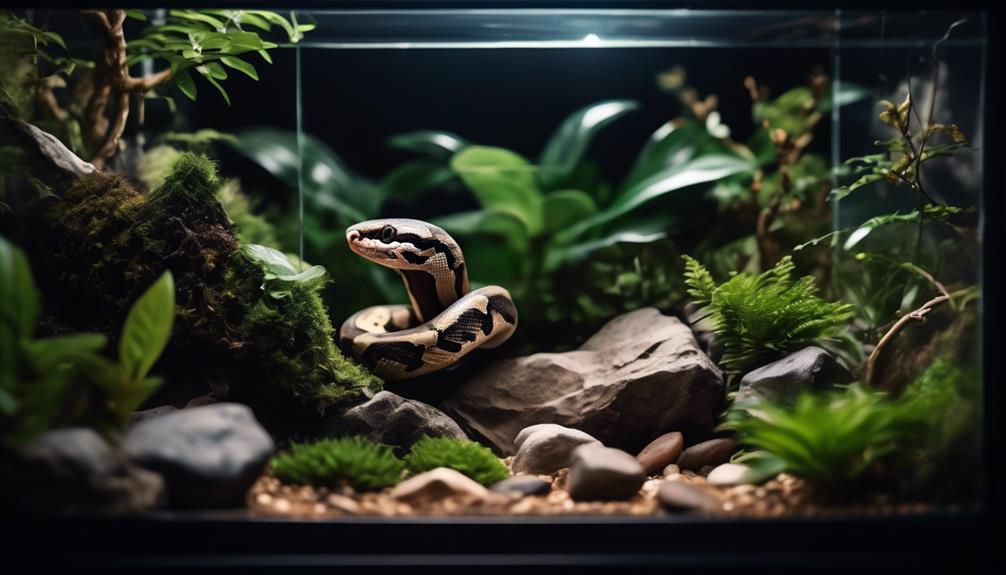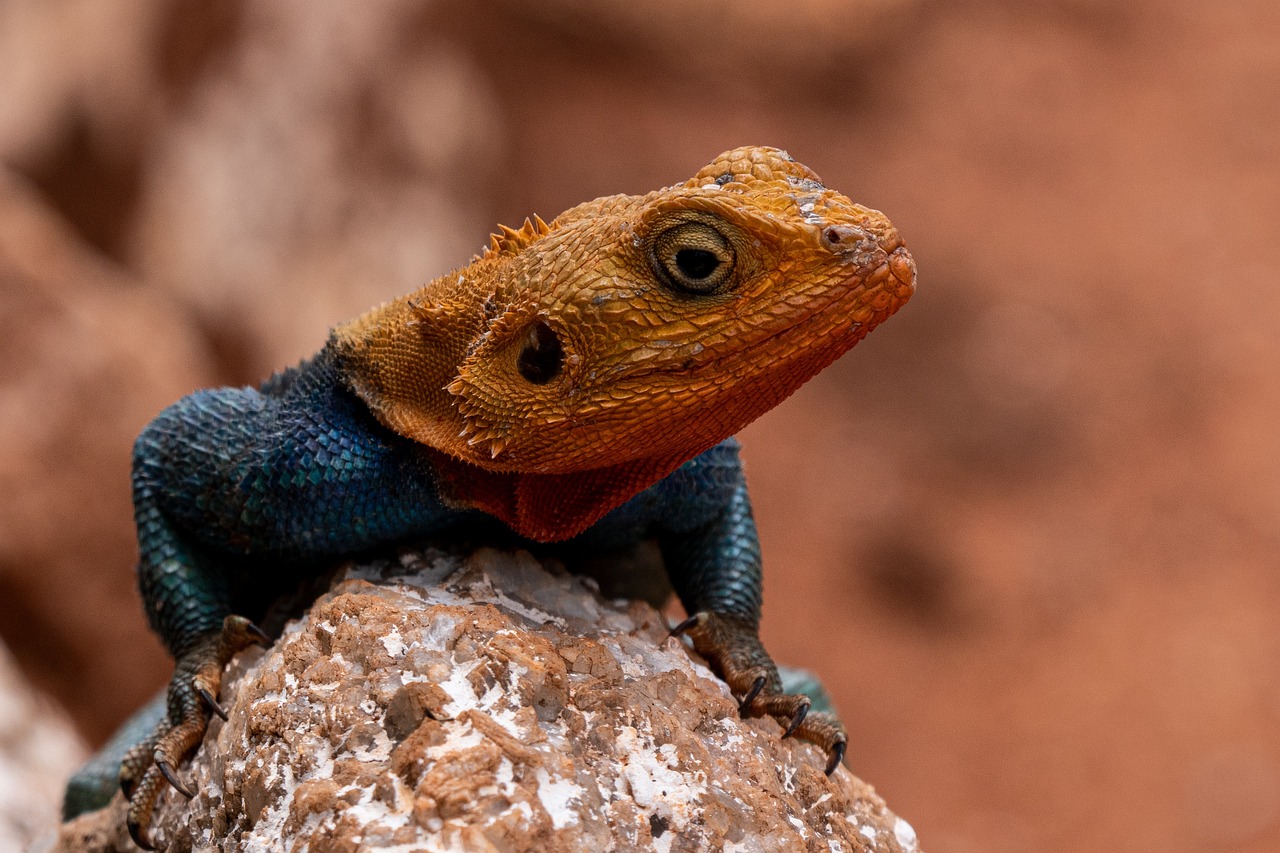Are you hesitant about creating the perfect home for your ball python because you're unsure where to start? We understand how overwhelming it can be to ensure all their needs are met, but fear not! In this article, we will guide you through each step, providing expert advice and practical tips to help you set up an ideal enclosure.
From the proper size and secure design to maintaining the right temperature and humidity levels, we've got you covered. But that's not all, there's one crucial aspect of your ball python's home that we haven't mentioned yet, and it's something that can greatly impact their overall well-being.
Curious? Well, you'll have to continue reading to find out!
Key Takeaways
- Choose an appropriate enclosure size and provide secure and escape-proof housing for your ball python.
- Create a temperature gradient with suitable heat sources and a thermostat to ensure proper thermoregulation.
- Maintain a humidity level of 50-60% and provide a large water bowl for soaking and drinking.
- Use natural-looking decor and enrichment items, such as hiding spots and climbing opportunities, while avoiding sharp or hazardous decorations.
Enclosure Setup

When setting up the enclosure for your ball python, it's crucial to choose an appropriate size based on the adult size of the snake. Ball pythons can grow anywhere from 3 to 5 feet long, so a tank that's at least 36 inches long and 18 inches wide would be suitable. It's important to provide enough space for the snake to move around comfortably.
Additionally, proper substrate selection is vital for the well-being of your ball python. Opt for substrate options that retain humidity, such as coconut husk or cypress mulch. This will help maintain the necessary humidity levels in the enclosure, which is crucial for the snake's overall health.
Lighting and Heating
To ensure the optimal conditions for your ball python, proper lighting and heating are essential components of their enclosure setup.
Choosing the right heat source is crucial to provide the necessary warmth for your snake. Options such as under-tank heaters or ceramic heat emitters can be used to achieve a warm side temperature of 88-92°F. It's important to use a thermostat to regulate the temperature and prevent overheating. This ensures that your ball python's environment remains consistent and safe.
Additionally, a cooler side temperature of 75-80°F should be provided to allow the snake to thermoregulate.
When it comes to lighting, it's best to use a low-wattage bulb or LED light to create a natural day-night cycle. UVB lights aren't necessary for ball pythons as they're nocturnal and don't require UVB exposure.
Humidity and Water

Maintaining the appropriate humidity level and providing access to water are crucial aspects of creating the perfect environment for your ball python.
Humidity control is essential because ball pythons originate from tropical regions and require a humidity level of 50-60%. To achieve this, use a hygrometer to monitor humidity levels in the enclosure and mist it daily or use a humidifier if necessary.
It's also important to provide a large water bowl for your snake to soak and drink from. Water bowl maintenance is necessary to ensure the snake has access to clean and fresh water. Regularly clean the water bowl and replace the water to prevent bacterial growth.
Decor and Enrichment
Now let's turn our attention to enhancing the environment for your ball python by providing appropriate decor and enrichment options.
Creating a natural-looking habitat can be achieved by incorporating artificial plants and branches into the enclosure. These not only add visual appeal but also provide hiding spots and climbing opportunities for your snake.
It's important to offer multiple hiding spots, such as caves or hollow logs, to make your ball python feel secure. Additionally, providing different textures like rough rocks or smooth branches can stimulate your snake's senses and encourage exploration.
When selecting decor, be sure to avoid sharp or hazardous decorations that could harm your snake. By carefully selecting and arranging decor, you can create a stimulating and enriching environment for your ball python.
Maintenance and Cleaning

When it comes to the maintenance and cleaning of your ball python's enclosure, it is essential to establish a regular routine to ensure the health and well-being of your snake. A proper cleaning schedule helps prevent the buildup of bacteria and maintain a clean and hygienic environment for your pet. Here is a table outlining an effective cleaning schedule for your ball python's enclosure:
| Cleaning Task | Frequency | Disinfecting Method |
|---|---|---|
| Spot cleaning | Daily | Remove waste and soiled substrate using gloves or tongs. |
| Water bowl | Daily | Empty, clean, and refill with fresh water. |
| Deep cleaning | Every 4-6 weeks | Remove all substrate, clean enclosure thoroughly, and replace with fresh substrate. |
| Disinfecting | Every 4-6 weeks | Use a reptile-safe disinfectant to eliminate bacteria and sanitize the enclosure. |
Frequently Asked Questions
How Often Should I Handle My Ball Python?
We recommend handling your ball python regularly to build trust and strengthen the bond. However, it's important to remember that each snake is unique, so monitor their behavior and adjust accordingly. Creating a comfortable environment is crucial for their overall well-being.
What Should I Feed My Ball Python and How Often?
To keep our ball python healthy, we feed it appropriately sized frozen-thawed rodents every 7-10 days. We alternate between mice and rats to provide a varied diet rich in nutrients.
Can I Keep Multiple Ball Pythons Together in the Same Enclosure?
No, it is not recommended to keep multiple ball pythons together in the same enclosure. Breeding ball pythons requires careful planning and separate enclosures. Creating a natural habitat for ball pythons is essential for their health and well-being.
How Long Do Ball Pythons Live in Captivity?
Ball pythons can live up to 30 years in captivity with proper care. To ensure their wellbeing, provide a suitable enclosure size, secure hiding spots, a temperature gradient, appropriate lighting and heating, and maintain proper humidity levels.
Are Ball Pythons a Good Choice for Beginners?
Ball pythons are a good choice for beginners due to their docile nature. They require specific care, including a suitable enclosure and proper heating and humidity. You can buy ball pythons from reputable breeders or reptile expos.
Conclusion
In conclusion, creating the perfect home for your ball python involves careful consideration of enclosure size, substrate, temperature gradient, humidity levels, hiding spots, and enriching decor.
By providing a comfortable and secure environment that meets all their needs, you can ensure the well-being and happiness of your beloved ball python.
For example, one case study showed that by implementing a proper temperature gradient and offering ample hiding spots, a ball python exhibited increased activity and feeding response.
Remember, a well-maintained and enriched enclosure is essential for your snake's overall health and happiness.

